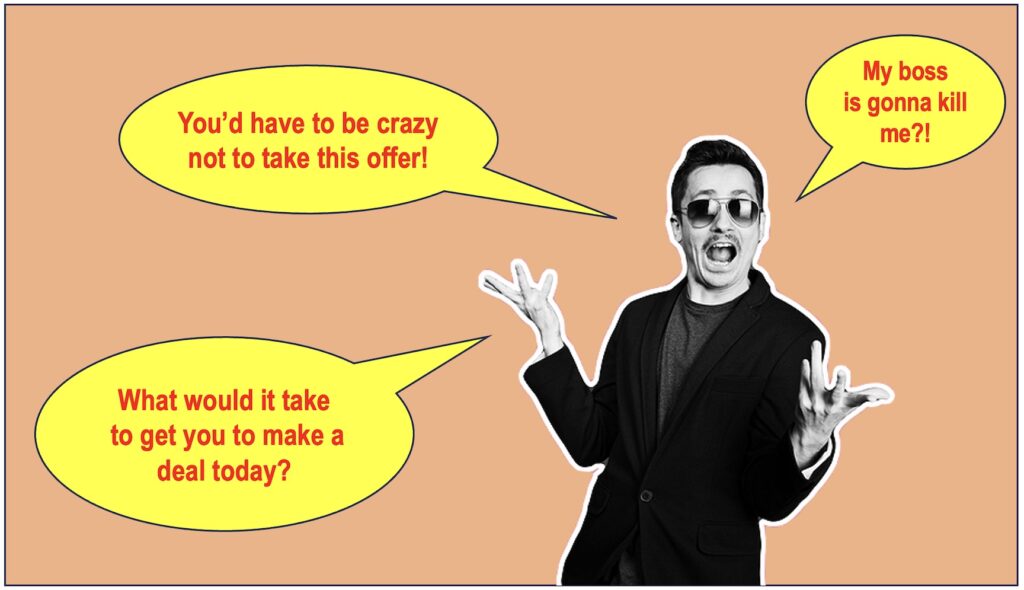
White paper writer tip #1: Stop selling
You must avoid the #1 problem with this format: Too much selling
The solution is simple: Stop writing sales pitches and calling them white papers.
Sponsors, recognize the danger of inserting a sales pitch into a white paper.
Stop pressuring your writers to include them.
Stop shooting yourself in the foot!
What’s the problem with selling?

Survey after survey points out that no white paper reader wants a sales pitch.
If a prospect wanted your pitch, they’d just call up your 1-800 line and ask for a sales rep.
But they seldom do that. More often, they search the Web for some help.
Business people want useful information to help them understand an issue, solve a problem, or make a decision.
Unless you give those readers what they’re looking for, your white paper will sink like a stone.
Even though a few people may download it, no one will read past the first page or two of a sales pitch. And, they certainly won’t pass it along to anyone else in their company.
All the resources you spent to create that white paper will achieve nothing.
In fact, you may infuriate a prospect so much they take your company off the shortlist of vendors to consider.
Instead of helping you win sales, your sales pitch can actually cost you sales.
Here are some tips to help white paper writers and sponsors stop using sales pitches.
Stop selling tip #1: Stop talking about your company or product
The tough fact is that no one cares about your company and how long you’ve been in business and how many awards you’ve won.
Your prospects only care about the problem they’re wrestling with now.
If they want to find out more about your company, they can click “About Us” on your website.
Instead, they clicked “Resources” or “Downloads” or that juicy title for your white paper that turned up in their Google search results.
So stop yammering away about your company and your product. You have better places to do that than in a white paper.
Tip: At the end of your white paper, include a short section “About the Company.” Use the same corporate boilerplate as in your company press releases. Keep it to half a page or less.
Stop selling tip #2: Stop saying “we” and “our” and “us”
When you stop talking about your company, product, team, excellence, commitment to customer service, and so on, you naturally stop talking about “we” and “our” and “us.”
That’s a good thing.
Tip: Talk about “you” and “yours”, namely your readers and your prospects.
Stop selling tip #3: Put yourself in your prospect’s shoes

The key to successful content marketing—including white papers—is to engage prospects around the problems they’re facing.
That’s what interests them.
That’s what keeps them up at night, and drives them to push a sales process forward.
Tip: Before you write a word, find out everything you can about your target audience.
Next, try to think like them. Worry like them. Google like them. Then write for them.
For more tips, see my article “Know your audience.”
If you have more than one audience, see my article
“How to write a white paper for multiple audiences.”
Stop selling tip #4: Ask yourself, “Who cares?”
A couple questions are ready to pop into every reader’s mind: “So what?” and “Who cares?”
You must test every white paper topic you dream up with these tough questions:
- Does my audience care?
- Are they dying to know about this?
- How will this help them?
Notice how a topic like “how great our product is” dissolves when you consider those questions. It’s like pouring sulphuric acid on to jello.
If there’s anything left at the bottom of the barrel after the acid drains out, you may have a topic worth developing.
Tip: Make sure the topic you’re writing about matters to your prospects. If in doubt, ask them.
Ask your customer advisory board, if the company has one.
Ask your sales and support teams. Create an online survey.
Do whatever it takes to test out your ideas before you publish them.
Stop selling tip #5: Push vague ideas into real-world benefits
Even in a backgrounder all about a product, stress concrete features and real-world benefits.
I recently saw a white paper that touted “our software is written in C# for the most up-to-date codebase.”
So what? This is neither a concrete feature nor a real-world benefit.
The fact that code is written in the C# programming language is just a fact about the product. To most readers, it’s an inconsequential fact.
Dissolve that in the acid of the three questions above, and all you have left is a few wisps of smoke.
As a white paper writer, you must push the laundry list of facts about a product into something your readers care about, something that speaks to them.
Here are some of the classic benefits that business people care about:
- Saving time
- Saving money
- Streamlining processes
- Boosting quality or reliability
- Boosting customer service
- Gaining a competitive edge
Think better, faster, cheaper.
If you can translate a C# codebase into one of these benefits, you have something to say. If you can’t, drop that item from your backgrounder.
Tip: Focus on concrete features and benefits that really matter to your prospects.
See tip #2 in this series on how to build an argument using Aristotle’s 3 elements of persuasion.
For more useful articles like this, get the free newsletter White Paper World.
This article originally published 22 March 2016. Last updated 17 February 2024.



